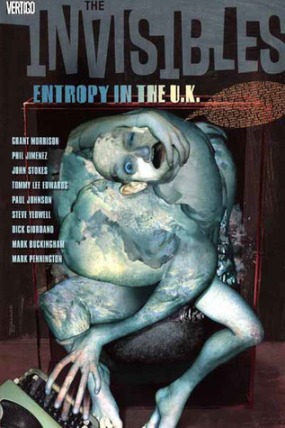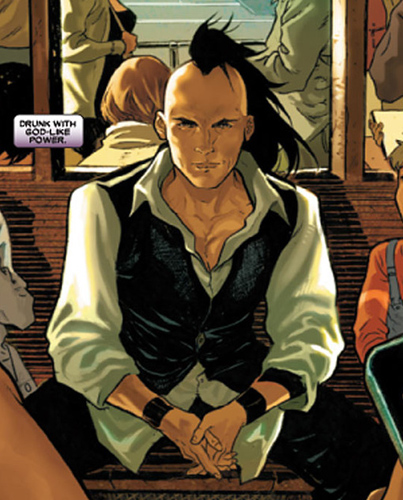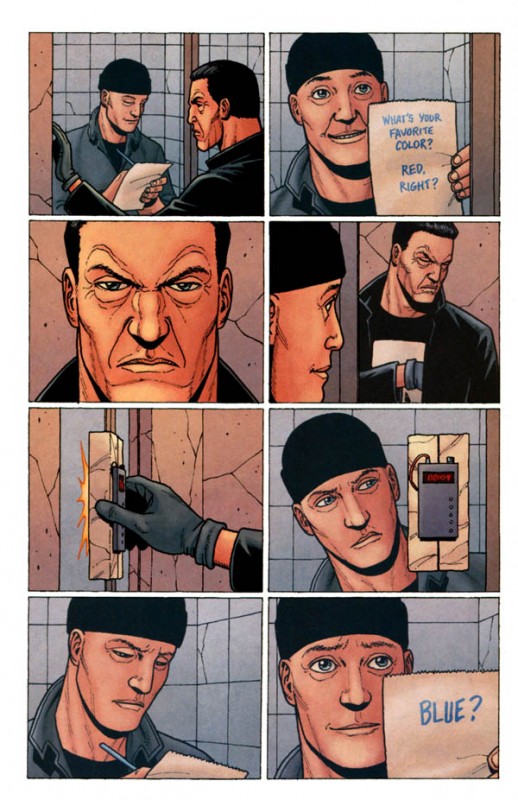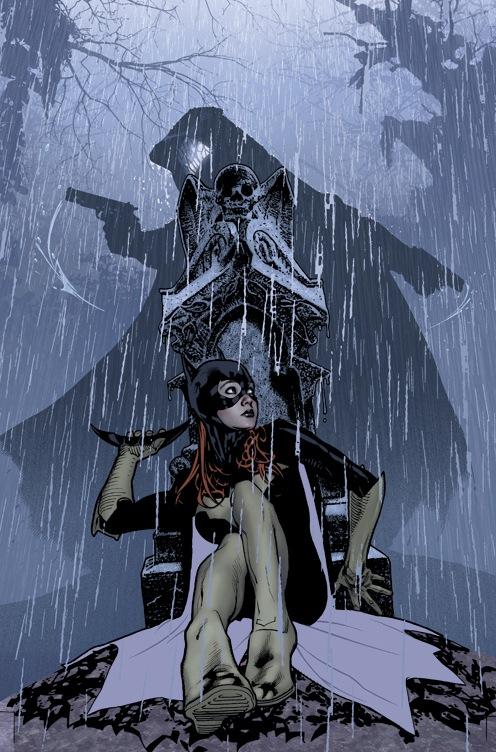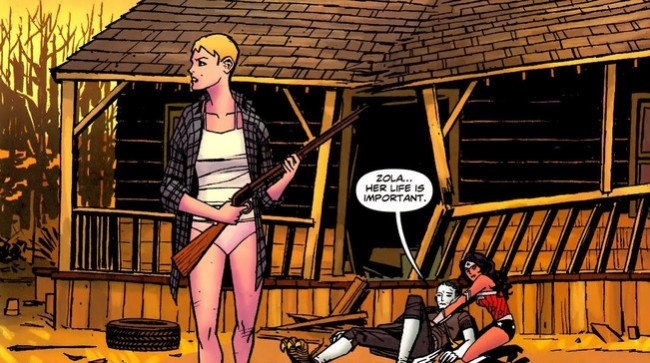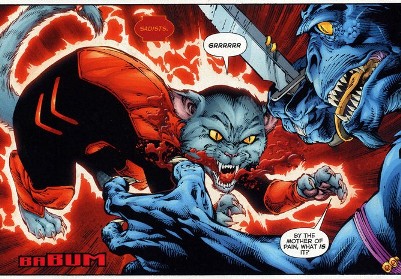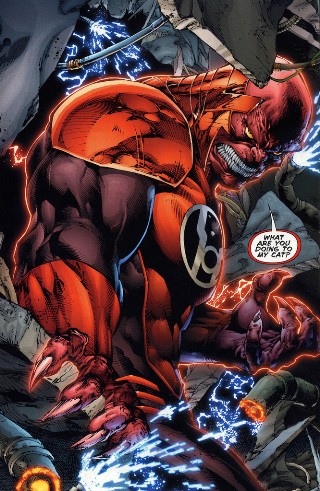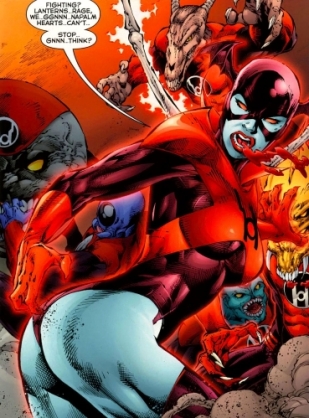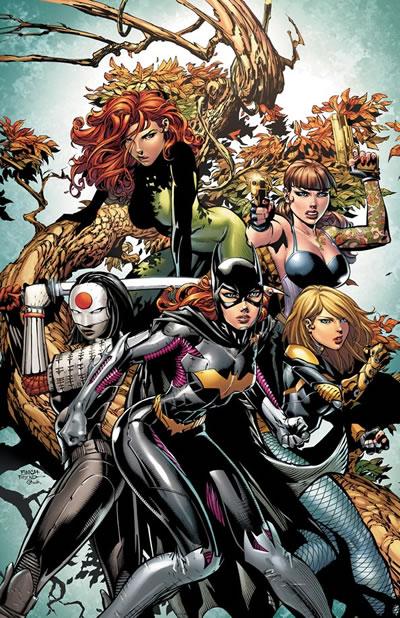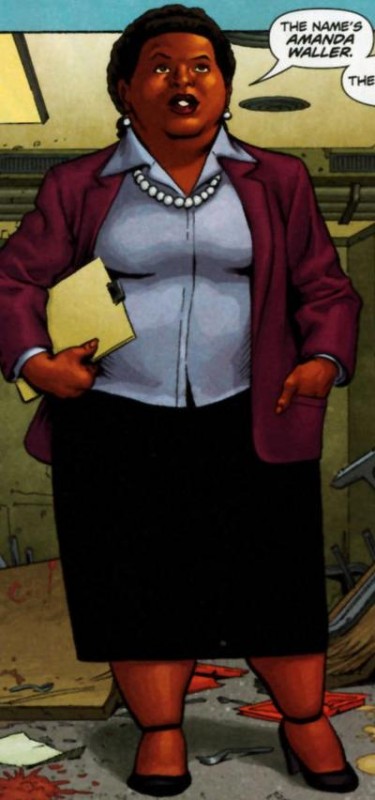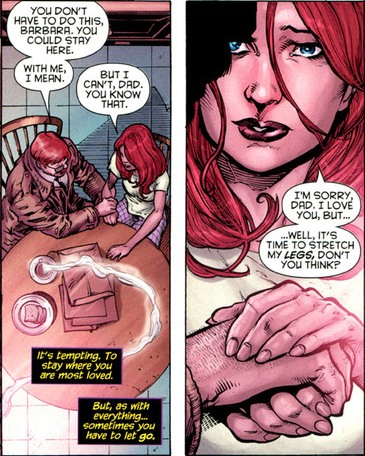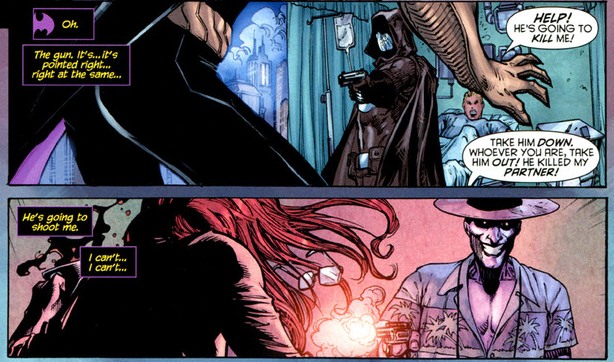This is a response to the overwhelming talk about Catwoman #1 on the internet. It started, of course, with Laura Hudson’s post on Comics Alliance, which I have mentioned before and which is now up to over 2100 comments. (If we could match that on this post, I would be pleased.) Next I heard about Catwoman on the Wait, What? Podcast with Jeff Lester and Graeme McMillan. They mentioned that Judd Winick made a statement about Catwoman, which he wrote. The statement goes like this:
This is a Catwoman for 2011, and my approach to her character and actions reflect someone who lives in our times. And wears a cat suit. And steals. It’s a tale that is part crime story, part mystery and part romance. In that, you will find action, suspense and passion. Each of those qualities, at times, play to their extremes. Catwoman is a character with a rich comic book history, and my hope is that readers will continue to join us as the adventure continues.
A quibble or two: Catwoman has almost always been a person who lives in our times, wears a cat suit, and steals, right up to the last issue of her last run, which I believe was in 2011 or 2010. None of that is new. The only new thing that you’re bringing to the book is the explicit sex scene at the end between Batman and Catwoman. Because the cover of Catwoman let me know it wasn’t for me, I didn’t pick it up at the store, so the only scene I saw from the comic, when reading about this, was the sex scene.
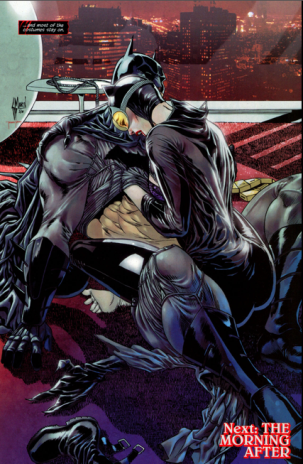
I thought it was great.
The art was not my cup of tea, but I thought the sex scene was a good innovation in continuity. First, I liked the idea for the relationship. I like superhero romance in general. I think it can be fun and interesting and sexy, and it necessarily turns the focus on the characters. Batman and Catwoman have been mutually involved before, but not, to my knowledge, when she was still a thief. I think it brings up all kinds of really uncomfortable dimensions to both characters that would be interesting to explore. What does it say about Catwoman that she either cozies up to a guy who is out there solely to put her in jail or has sex with him in the belief that he won’t take her to jail? And what about Batman? He knows she’s a thief and knows where her apartment is and knows that she’s putting innocent people in danger with her illegal activities. And yet I didn’t see him bring out the cuffs. What does it say that if Batman is attracted to you, and you have sex with him, he’ll let you get away with a crime? Suddenly both characters have serious feet of clay, and they’re in a situation that cannot last. It’s interesting.
What’s more, I was fine with the explicitness of the scene. I think the fact that it made clear, through art and story, that both of them are angry with themselves for doing any of this, and the last panel, with them collapsed together, not looking at each other, just before all hell will probably break loose was a good cliffhanger, in my opinion.
Ah – but then I borrowed and read the rest of the book. And learned that all of that ‘romance’ and ‘passion’ and woman ‘of our times’ stuff was ridiculous.
To see why, let’s work back from the end. Here we have Batman and Catwoman, two people who are deliberately are in a bad relationship, but are so passionate that they just can’t help themselves. You can make a case for this being a sexual woman, who makes a romantic choice that will pose problems for her later. Fine. Interesting, even.
Just before that, Selina is at a party, trying to pick up tips for where to find high-value items that she can steal. She’s in a red wig and posing as a bartender. Suddenly she sees a man, who she says is ‘supposed to be locked up.’ She flashes back to a scene from her adolescence. She huddles against a wall, terrified and crying, as the man uses a gun to kill a woman right in front of her. Back at the party, the man goes to the bathroom. Selina follows him. She finds him with his back to the door, over the toilet, obviously about to pee. She gets his attention, and the first panel we see of her in this scene is this:
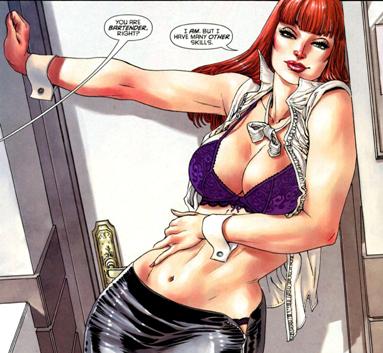
He makes some comment, she moves to embrace him, and then beats the hell out of him. She smashes his face against the sink, and then claws and hits him as blood splatters everywhere. Then she changes into her Catwoman suit and flies out of the party, knocking down everyone in front of her and getting down the hall before anyone at the party can even make it out the door. She’s hurt and sad, and ‘just wants to go home.’
Here’s the big stumbling point. Why did she open her shirt just then? I’m serious. Consider why she would do that.
Well, maybe she was trying to distract him?
No.
The panel before she spoke to him, he was completely relaxed, facing away from her, his pants undone, and unaware that she was even in the room. Not to mention this is a woman who is a good enough fighter to fight her way through a mobbed-up party, tackle and pin Batman, and leap out into the air to escape a group of guys with guns. She doesn’t need a distraction to beat up a white-haired man who needed a gun to intimidate an unarmed woman ten years ago.
Maybe she wanted him to see her coming?
No.
There’s no indication that he ever knows her name, or she wants him to know who she is. If she wanted it to be real payback she would have taken off the wig, not the shirt.
The lack of a concrete reason for her to do this indicates that this is a gratuitous and inappropriate shot of Catwoman with her shirt off. That’s not necessarily true. There is a character-appropriate reason for doing this, but it changes things.
Remember, this is a guy who stopped her cold a panel earlier. He literally made her flash back to what had to be one of the most terrifying and helpless moments of her life. And her immediate reaction was to display herself sexually to him. This display isn’t the same as sexual power. She’s not grabbing his crotch, or making him sexually afraid, or even sexually intimidated. She’s trying to please him in order to make herself feel more powerful and in control, even though it’s clear that she can beat him through strength alone. This is how she reacts to fear, disgust, and helplessness; being sexy.
Go back to the Batman and Catwoman tryst at the end. Batman is a guy who knows where she lives, who she thinks might know her name, and who she knows ‘should’ be hauling her to prison. Kind of puts another perspective on it, doesn’t it? It’s not ‘passion’ or ‘romance’ anymore. It’s not Selina being sexual. It’s a response to fear and powerlessness – a need to use sex to win over a man and make herself feel in control. This makes it pretty sad when she tackles the guy who broke into the apartment she was using as a safehouse and proceeds to have conflicted, angry sex with him. If we take these two incidents together, this sex scene is not empowered female sexuality, it’s a panic response.
And then what does that say about Batman? Before, he was a man who ruthlessly hunted down criminals and brought them to justice – but who let it slide when it came to the woman he was attracted to and who had sex with him. Now we see that sex is Selina’s response to stress and trauma. In essence, she has a compulsion that makes her try to bargain her way out of difficult situations with sex, and Batman, knowingly or not, is going along with it. That’s really awful. It’s a demonstration of how morally bankrupt it is for Batman to have sex with her in the first place, and how deadened she is. This book is looking pretty dark. It’s about a woman who’s clearly been abused and whose first, instinctive response to danger is to try to appeal to people through sex. It still can make sense, though. It can still be a good character portrait.
Now let’s go farther back. The first page has her fleeing her apartment as a gang is pounding down her door.
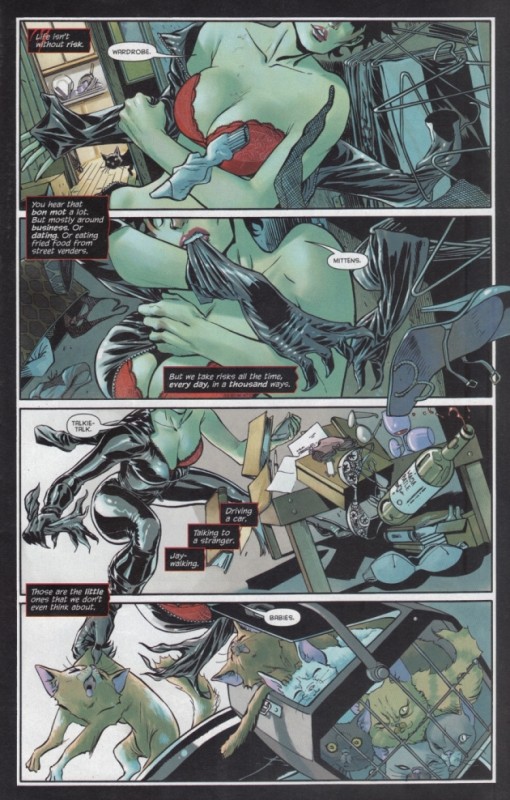
The more astute reader will notice that the voice is flippant, the boobs are front and center, and she has no head. Given the intensity and bleak sexiness that we see in the last half of the book, this doesn’t really fit in well, but maybe her introductory panel will show us more of her fear –
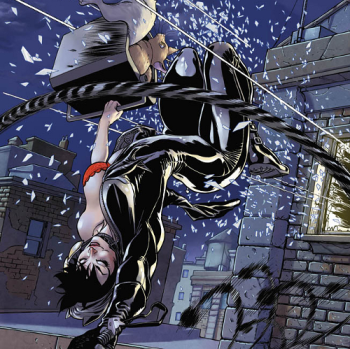
This panel can be summed up as, “Wheee! Mortal danger is fun and my shirt is just coincidentally open!”
And what about the cover to this issue. Does it expose the fun she has running free through the night ahead of her attackers? Does it show her desperation and dark past? Does it emphasize the romance and passion?
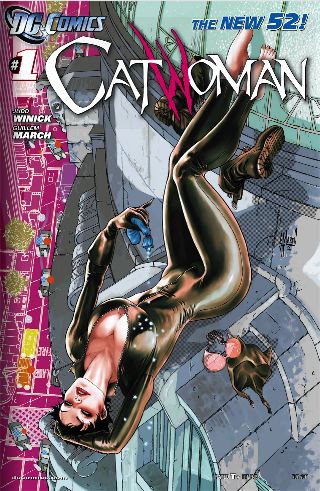
I think we can all agree it shows none of them.
And the reason it shows none of them is none of them exist in this book. This isn’t a book about a dark, desperate character who clings to sexuality as a way of trying to deal with a crazy world filled with mystery and action and violence. This isn’t a book about a fun-loving, sexy thief. This isn’t a book about a star-crossed romantic thief in a relationship with her adversary. This is a book about boobs, and Selina Kyle will be whatever kind of character she needs to be in order for her breasts to be exposed as much as possible. When people talk about mindless sex dolls, ciphers, or degrading portrayals of women, this is what they mean. There’s no character there – no story and no mystery and no adventure and no romance and no passion. There’s whatever will put the character in a suggestive pose. So let me change the statement.
This is a Catwoman for 2011, and my approach to her character and actions is tits. There are tits on the cover and there are tits on the front page and the last page cliffhanger is meant to show the promise of more tits in future issues. In these, you will find action and suspense and passion, and each of those qualities will go to extremes that cause Catwoman to get her tits out all the time, because that’s the way she responded to everything in this book. Let’s face it, the only reason that we didn’t call this Catwoman #Tits is because we made a line-wide stylistic choice to start all new books at #1, and we’re not going to change that for a flimsy, inconsequential tittybook like this issue of Catwoman.


